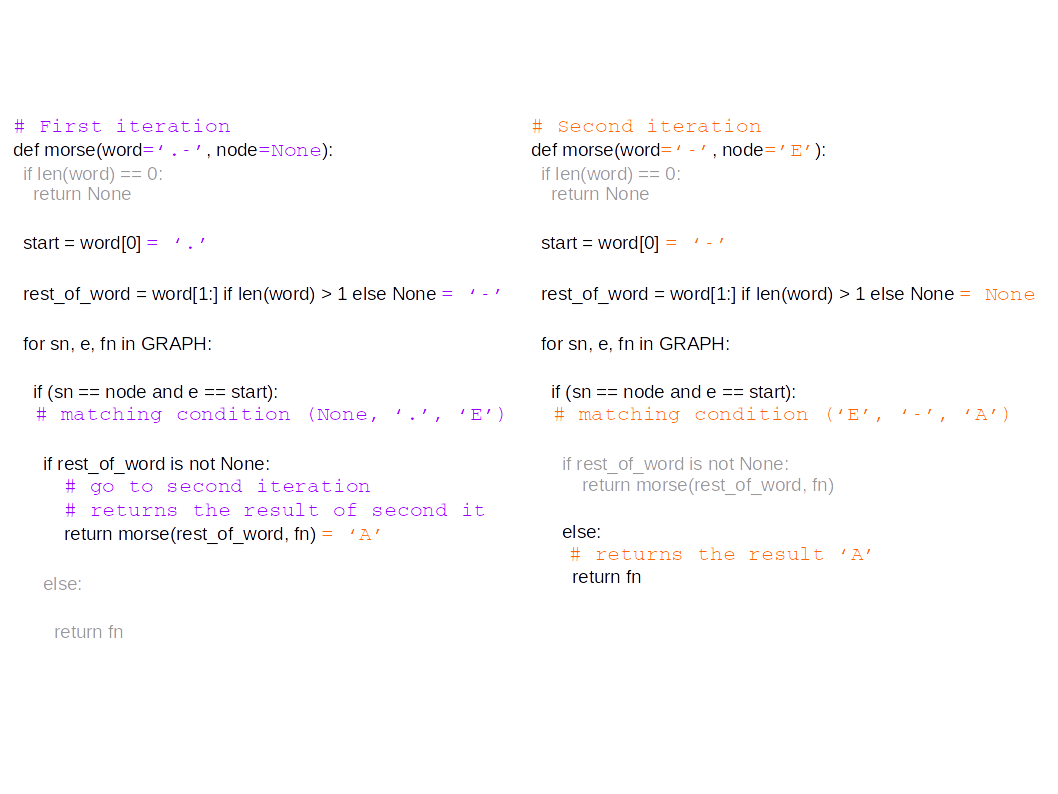Coding exercice: kind of morse code with errors
December 03, 2018
Challenge
The challenge was the following:
Given a “morse” code following the rule describe on the image below:

For instance:
- ”.” = “E”
- ”..” = “I”
- ”-.-“ = “K”
You will be given a “word” made of up to three symbols. Some symbols may be missing and replaced with a question mark “?”. You have to determine all possible letters matching the word. For instance, if given “?”, the program should return “[‘E’, ‘T’]”. For the input word “.?”, it should return “[‘I’, ‘A’]”.
Wow wow wow. That was my first reaction. Then I thought of the work I have been doing on graphs for the past few weeks and the following idea came to my mind.
My solution
This exercice makes me think of a graph structure, with path search. So, I started by creating a graph, where each edge is defined by a starting node (letter at level l), ending node (letter at level l+1) and the symbol between them:
DASH = "-"
POINT = "."
GRAPH = (
# (node_start, link, node_end)
(None, POINT, "E"),
(None, DASH, "T"),
("E", POINT, "I"),
("E", DASH, "A"),
("I", POINT, "S"),
("I", DASH, "U"),
("A", POINT, "R"),
("A", DASH, "W"),
("T", POINT, "N"),
("T", DASH, "M"),
("N", POINT, "D"),
("N", DASH, "K"),
("M", POINT, "G"),
("M", DASH, "O")
)Exploring the graph with no missing letter
With this graph structure, you can see that, for instance, “..” corresponds to “None POINT ‘E’ POINT ‘I’” = ‘I’. Let’s write the corresponding code to “read” the graph:
def morse(word, node=None):
if len(word) == 0:
return None
start = word[0]
rest_of_word = word[1:] if len(word) > 1 else None
for sn, e, fn in GRAPH:
if (sn == node and e == start):
if rest_of_word is not None: # continue exploring the graph for the rest of the word, staring from the current final node
return morse(rest_of_word, fn)
else: # if word iteration is done, the current final node is the result
return fnCode that can be tested with:
if __name__ == "__main__":
print(morse("..")) # 'I'
Here is a picture illustrating what is going on:

Extending previous code to take into account missing letters
Our code should now return a list of possiblities instead of a single letter. Here are the changes to the previous version in order to make it work:
QUESTION = "?"
def morse2(word, node=None):
if len(word) == 0:
return [] # returns an empty list if no solution
start = word[0]
rest_of_word = word[1:] if len(word) > 1 else None
possibilities = [] # the list that will store our final result
for sn, e, fn in GRAPH:
if (sn == node
and (start == e or start == QUESTION)): # change condition, we also consider this edge if the current letter is a question mark
if rest_of_word is not None:
ps = morse2(rest_of_word, fn) # our morse2 function returns a list of possibilities, that must all be taken into account in the final result
possibilities.extend(ps)
else:
possiblities.append(fn)
return possibilitiesAnd, as usual, an example usage of this function:
if __name__ == "__main__":
print(morse2("?.")) # ['I', 'N']
Works like a charm! I love graphs!